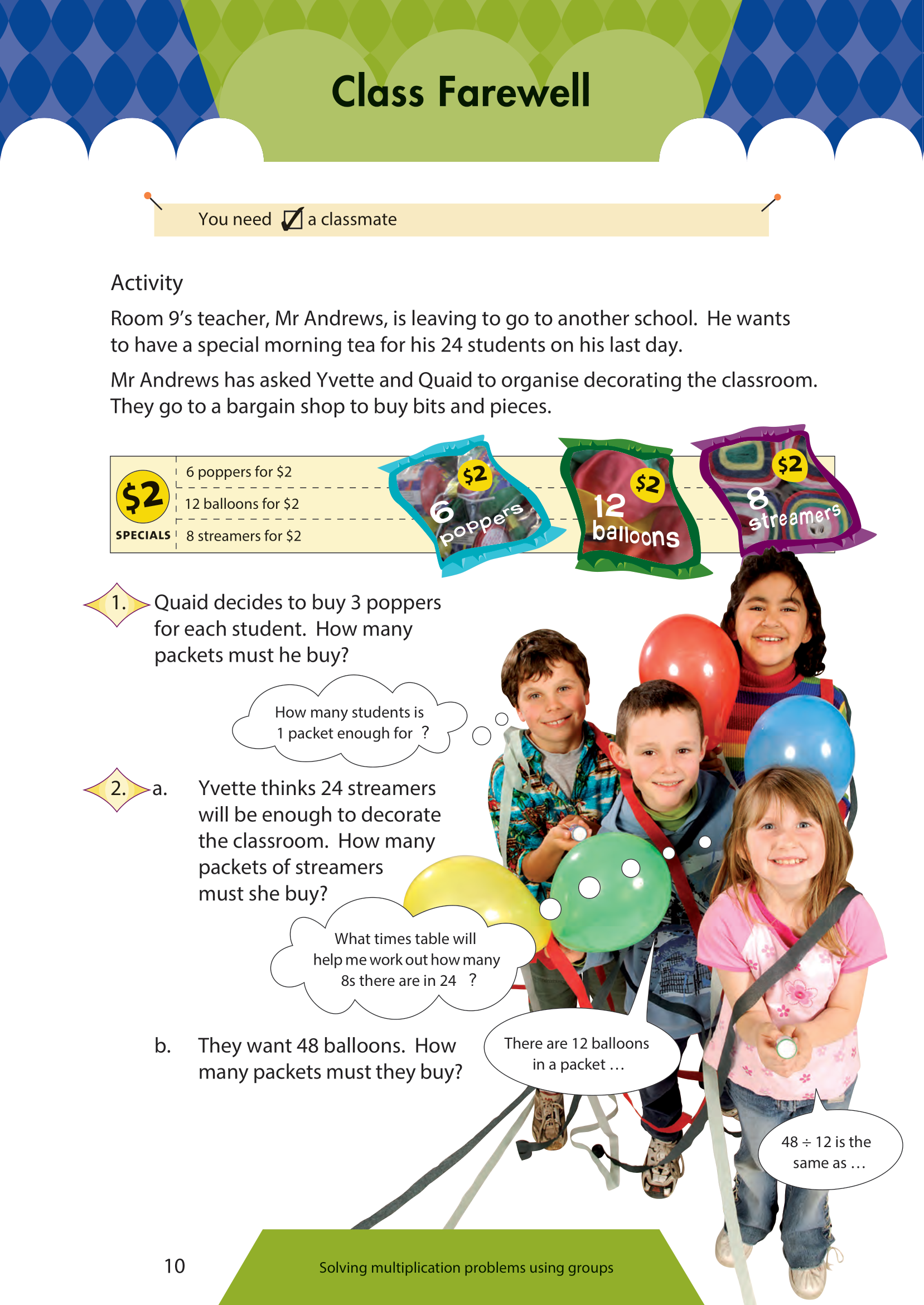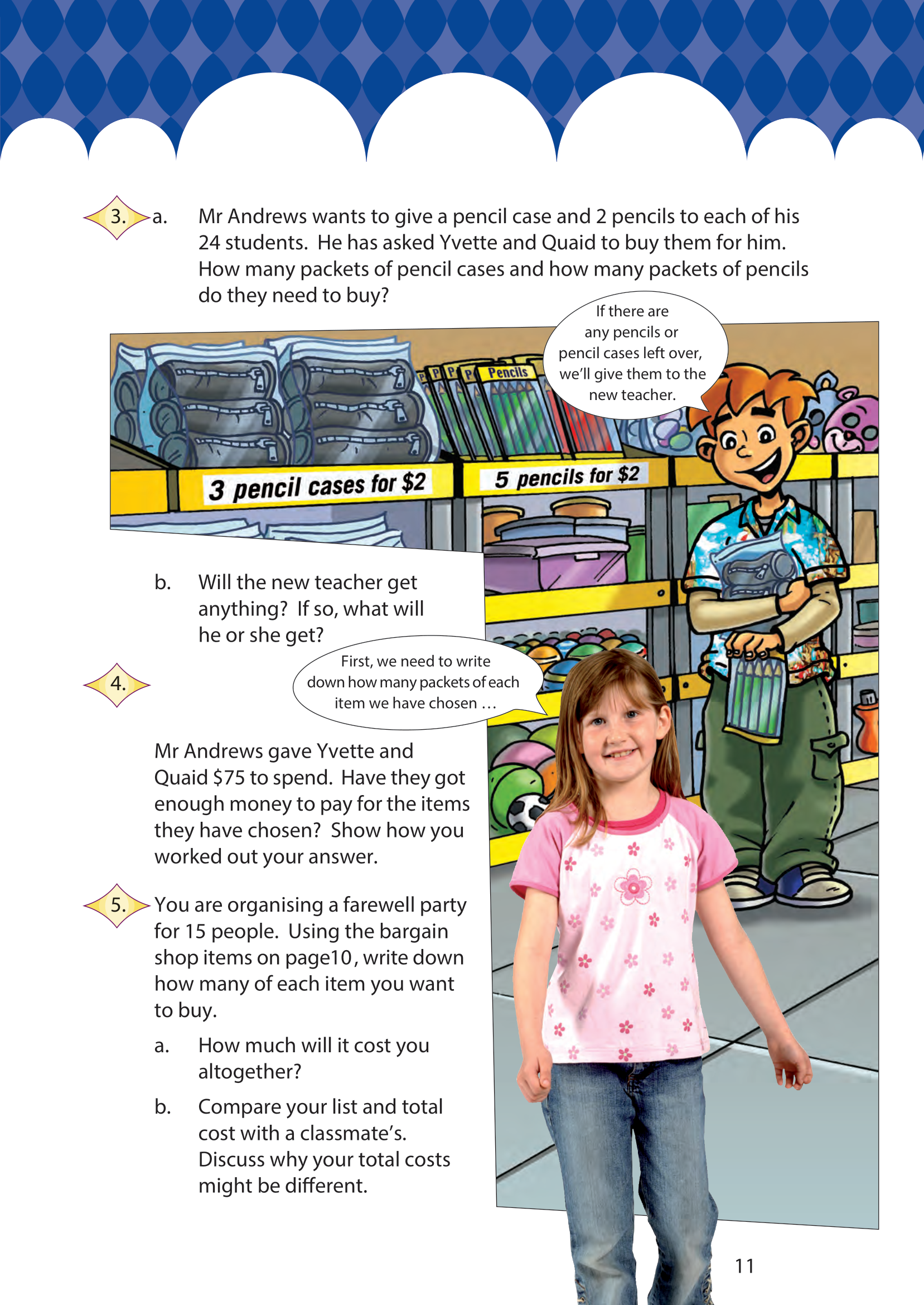This is a level 3 number activity from the Figure It Out series. It relates to Stage 6 of the Number Framework.
Click on the image to enlarge it. Click again to close. Download PDF (663 KB)
use basic facts to solve division problems
Number Framework Links
Use this activity as a guided learning experience with groups at stage 4 or stage 5. It could be used as an independent activity by groups at stages 5–6.
FIO, Levels 2-3, Multiplicative Thinking, Class Farewell, pages 10-11
A classmate
This activity provides a context for applying skills of deriving facts from known facts. The context will be familiar to many students (the $2 bargain shops) and is used to pose questions with a range of groupings. The use of 24 students in the class allows for groupings of 2, 3, 4, 6, 8, and 12. The questions build to finding the total cost for all the items. For this, the students will list the items chosen and multiply by $2.
There are two steps to question 1. Students may work out how many packets are needed for 1 popper each and then multiply that number by 3, or they may work out how many poppers 3 per person would be and then find the number of packets. The prompt on the page suggests finding out how many students 1 packet will provide for, which is a third method. Encourage your students to begin by describing how they are going to tackle the problem; get them to rephrase the question in their own words to show that they understand the multiplicative structures that are implicit within it. Then ask them to record their solution strategies and to share them in discussion.
Questions 2 and 3 extend the ideas described in question 1, using new amounts. To extend your students further, ask additional questions: What if there were 30 people in the class? What if we wanted twice as many balloons?
For students who are struggling, model the groupings using beans or counters and snap-top bags for the products. To encourage imaging, make 1 bag of each “product” and then let the students use the single bags to work out the problems rather than using multiple bags of each grouping. Discuss with the students how they could use the 1 bag to help them solve the problems.
Question 4 focuses on money rather than on item amounts, although the students will need to use all their earlier answers. Ask them to estimate how much they think the total might be so that they have an idea of a reasonable answer before they do any actual working out.
You could use the activity in guided instruction up to this point and then ask the students to use what they have found to complete question 4 independently or in pairs. This helps to develop number sense in calculation. The resulting work, and their own lists from question 5, could be shared at your next group session.
Answers to Activity
1. 12 packets. (1 packet is enough for 2 students. 24 ÷ 2 = 12, so 12 packets is enough for 24 students.)
2. a. 3 packets. (8 + 8 + 8 = 24 or 24 – 8 – 8 – 8 = 0; 3 x ? = 24)
b. 4 packets. (48 ÷ 12 = 4. Or, using the hint given, 48 ÷ 12 is the same as ? x 12 = 48. If you don’t know that fact, you could go: ? x 6 = 24; 4 x 6 = 24, so 4 x 12 = 48.)
3. a. 10 packets of pencils and 8 packets of pencil cases. (They need 48 pencils and 24 pencil cases. 5 x 10 = 50 pencils, and 3 x 8 = 24 pencil cases.)
b. 2 pencils. (50 – 48 = 2)
4. Yes. The total cost is $74, which is $1 less than $75. One possible way to work out your answer is: (12 x $2) + (3 x $2) + (4 x $2) + (10 x $2) + (8 x $2) = 24 + 6 + 8 + 20 + 16 = 74.
5. a.–b. Answers will vary. Lists and total costs will vary depending on what items you choose and how many of each.

